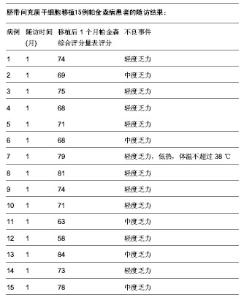| [1] Smith GA, Isacson O, Dunnett SB. The search for genetic mouse models of prodromal Parkinson's disease. Exp Neurol. 2012;237(2):267-273.[2] Eun-Ju K, Young-Hyurk L, Min-Jeong K, et al. Transplantation of porcine umbilical cord matrix mesenchymal stem cells in a mouse model of Parkinson's disease. J Tissue Eng Regen Med. 2013;7(3):169-182.[3] Kordower JH. Stem cells and gene therapy in PD: future directions. Parkinsonism Relat Disord. 2012;18:10.[4] Moore CG, Schenkman M, Kohrt WM, et al. Study in ParkinsonDisease of Exercise (SPARX):Translating high-intensity exercise from animals to humans. Contemp Clin Trials. 2013;36(1):90-98.[5] Smith GA, Isacson O, Dunnett SB. The search for genetic mouse models of prodromal Parkinson's disease. Exp Neurol. 2012;237(2):267-273.[6] Wang F, Kameda M, Yasuhara T, et al. GDNF-pretreatment enhances the survival of neural stem cells following transplantation in a rat model of Parkinson's disease. Neurosci Res. 2011;71(1):92-98.[7] Nishimura K, Takahashi J. Therapeutic application of stem cell technology toward the treatment of Parkinson's disease. Biol Pharm Bull. 2013;36(2):171-175.[8] Yan M, Sun M, Zhou Y, et al. Conversion of human umbilical cord mesenchymal stem cells in Wharton's jelly to dopamine neurons mediated by the Lmx1a and neurturin in vitro: potential therapeutic application for Parkinson's disease in a rhesus monkey model. PLoS One. 2013; 8(5): e64000.[9] Arenas E. Towards stem cell replacement therapies for Parkinson’s disease. Biochem Biophys Res Commun. 2010; 396(1):152-156.[10] Luo Y, Kuang SY, Hoffer B. How useful are stem cells in PD therapy. Parkinsonism Relat Disord. 2009;15 Suppl 3:S171-175.[11] Zeng X, Couture LA. Pluripotent stem cells for Parkinson's disease: progress and challenges. Stem Cell Res Ther. 2013; 4(2):25.[12] 袁源,杨树源,韩忠朝,等.人脐带间充质干细胞分离纯化及基本牛物学特性研究[J]. 中华实验外科杂志,2006,5(3):230-236.[13] 胡静波,周燕,蒋丹丹,等. 体外扩增过程中人骨髓间充质干细胞的增殖与分化规律[J]. 细胞与分子免疫学杂志,2006,22(1):7-10.[14] 高国栋,张华,王学廉,等.帕金森病的定向手术适应症[J]. 中华神经外科杂志,2002,18(1):12-16.[15] 赵彬,徐海龙,潘雷,等.辛伐他汀减少三磷酸甘油醛脱氢酶的聚集及神经元凋亡[J].卒中与神经疾病, 2013,20(1): 23-26,49.[16] 王云甫,杨超,孙延鹏,等.肌萎缩侧索硬化患者脑脊液对间充质干细胞增殖分化的影响[J].卒中与神经疾病, 2012,19(6): 328-331.[17] 李秀丽,张兆辉,张振涛. 帕金森病患者伴发精神症状的发生率及危险因素研究[J]. 卒中与神经疾病, 2012,19(5):308-310.[18] 杨明健. 艾司西酞普兰治疗帕金森病抑郁患者的疗效观察[J]. 卒中与神经疾病, 2012,19(4):243-244. [19] 宋金辉,罗韵文,谭晓东, 等.帕金森病患者血清中铜、铁、锰、锌和维生素E、维生素B12的测定[J]. 卒中与神经疾病, 2012,19(4): 219-221. [20] 陈涛,贾佳,叶飞, 等. PEP-1介导铜锌超氧化物歧化酶对帕金森病小鼠氧化应激损伤的保护作用[J]. 卒中与神经疾病, 2012, 19(4): 199-201,206. [21] 黄杰,张振涛,陈春暖,等.CDK5在鱼藤酮诱导的多巴胺能神经元凋亡中的作用[J].卒中与神经疾病, 2012,19(3):134-137. [22] 胡丹,汪宁,张振涛,等.姜黄素对多巴胺能细胞的保护作用研究[J]. 卒中与神经疾病, 2011,18(6):326-328,347. [23] 宋艳玲,赖天宝,李嫚,等. VEGF基因修饰MSCs移植对脑梗死大鼠血管源性机制的实验研究[J]. 卒中与神经疾病, 2011,18(6): 323-325,370.[24] 胡智伟,邹小冬.具有帕金森样症状患者的相关疾病探讨[J]. 卒中与神经疾病, 2011,18(4):237-238.[25] Lees AJ, Hardy J, Revesz T. Parkinson's disease. Lancet. 2009;96(8):638-642. [26] Kupsch A,Oertel WH, Earl CD,et al. Neuronal transplantation and neurotrophic factors in the treatment of Parkinson's disease-update February 1995. J Neural Transm Suppl. 1995;46:193-207.[27] Bjorklund LM,Sánchez-Pernaute R, Chung S, et al. Embryonic stem cells develop into functional dopaminergic neurons after transplantation in a Parkinson rat model. Proc Natl Acad Sci U S A. 2002;99(4):2344-2349. [28] Carvey PM, Ling ZD, Sortwell CE, et al. A clonal line of mesencephalic progenitor cells converted to dopamine neurons by hematopoietic cytokines:a source of cells for transplantation. Exp Neurol. 2001;171(1):98-108.[29] Jin GZ, Cho SJ, Choi EG, et al. Rat mesenchymal stem cells increase tyrosine hydroxylase expression and dopamine content in ventral mesencephalic cells in vitro. Cell Biol Int. 2008;32(11):1433-1438.[30] 张儒有,郑永日,胡韶山. 神经干细胞移植治疗脑卒中后遗症50例临床效果分析[J]. 中国组织工程研究与临床康复, 2006, 13(9):514-517. [31] Sortwell CE, Collier TJ, Sladek JR Jr. Co-grafted embryonic striatum increases the survival of grafted embryonic dopamine neurons. J Comp Neurol. 1998;399(4):530-540.[32] During MJ, Kaplitt MG, Stern MB. Subthalamic GAD gene transfer in Parkinson disease patients who are candidates for deep brain stimulation. Human Gene Ther. 2001;12(12): 1589-1591.[33] Taylor H, Minger SL. Regenerative medicine in Parkinson's disease: generation of mesencephalic dopaminergic cells from embryonic stem cells. Curr Opin Biotechnol. 2005; 16(5): 487-492.[34] Greene R. Cell-based therapies in Parkinson's disease. Curr Neurol Neurosci Rep. 2009;9(4):292-297.[35] 王有为,韩之波,严淑琳,等.人脐带间充质干细胞冻存复苏后的生物学特征[J].中国组织工程研究与临床康复, 2010,14(10);1729- 1733. [36] 杨兴肖. 间充质干细胞对移植物抗宿主病的免疫调节作用[J]. 中国肿瘤生物治疗杂志, 2011,16(3):842-843. [37] 徐昊. 细胞移植治疗帕金森病移植细胞的选择与调控[J]. 中国微侵袭神经外科杂志, 2011,16(12):570-573.[38] 武晓华,陈乃耀. 脐血间充质干细胞治疗帕金森病的研究进展[J]. 中西医结合心脑血管病杂志, 2011,9(1):101-103. [39] 张国柱,盛守权. 帕金森病的治疗研究进展[J]. 基层医学论坛, 2011,17(10):794-796.[40] 冯建勋,腊晓林,马艳. 两步法分离和培养人羊水来源胚胎间充质干细胞的生物学特征[J]. 中国组织工程研究与临床康复, 2010,13(45):8854-8860. [41] Liao W,Xie J, Zhong J, et al. Therapeutic effect of human umbilical cord multipotent mesenchymal stromal cells in a rat model of stroke. Transplantation. 2009;87(3):350-359.[42] 李加美,朱华,刘颖. IL-10在人骨髓间充质干细胞移植治疗食蟹猴脑缺血中的作用[J]. 中国比较医学杂志, 2009,19(12):1-4. [43] Ball LM, Bernardo ME, Roelofs H. Cotransplantation of ex vivo expanded mesenchymal stem cells accelerates lymphocyte recovery and may reduce the risk of graft failure in haploidentical hematopoietic stem-cell transplantation. Blood. 2007;110(7):2764-2767.[44] 池颖,王有为,韩之波. 不同供者来源及不同传代次数人脂肪间充质干细胞端粒酶的活性检测[J]. 中国组织工程研究与临床康复, 2009,13(45):8825-8828.[45] Dominici M, Le Blanc K, Mueller I. Minimal criteria for defining multipotent mesenchymal stromal cells. The International Society for Cellular Therapy position statement. Cytotherapy. 2006;8(4):315-317. |



